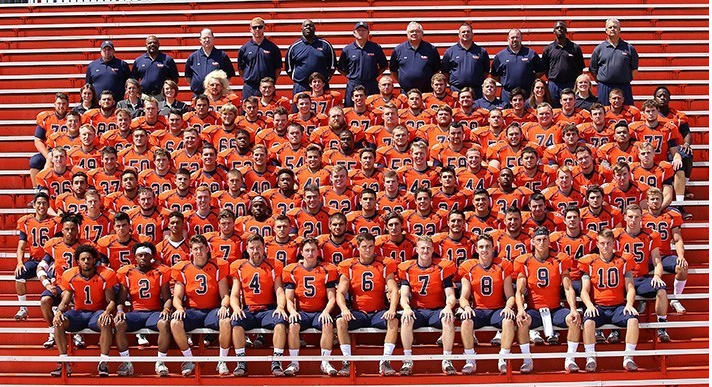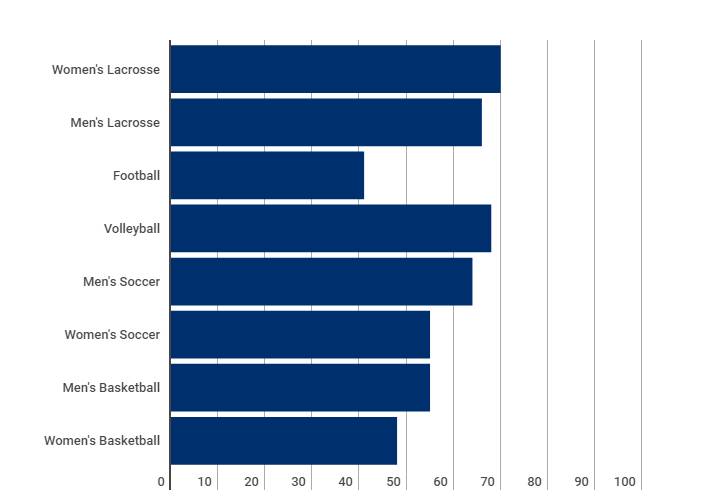Retention Rates Vary Widely Among Varsity Teams at Gettsyburg College

The 2016 Gettysburg College Football Team, with 32 first years, 13 of whom would play for four years (Photo courtesy of Gettysburg College Athletics)
By Garrett Glaeser, Sports Editor
While seven in ten student-athletes who join the women’s lacrosse team at the outset of their college careers are still on the team by the time their senior year rolls around, less than half of football players stay on the team through their senior season.
According to an analysis of eight Gettysburg College teams (men’s and women’s basketball, football, men’s and women’s lacrosse, men’s and women’s soccer, and volleyball) over a ten-year span from 2010 to 2020, 52 percent of student-athletes who start playing a sport their first year stay on the team through their senior year. Women’s sports have a higher retention rate than men’s (58 percent vs. 50 percent).

Percentage of athletes retained for all four years, 2016-2020 (Chart Gauri Mangala/The Gettysburgian)
Executive Director of Athletics Michael Mattia would not comment on any team’s specific retention rate, but he said that retaining athletes is crucial to the success of the athletic program and that coaches need to connect to their players and build a positive team culture.
“[Connecting with athletes] is certainly part of the criteria that I will be looking for in any head coach search that may take place in the future,” he said, noting that it was a criterion in the hiring of both new football coach Maurice Banks and new swimming coach Greg Brown.
Retention is a particularly acute issue for the football team, which has not retained more than half of its players in the last decade and whose retention rate is 11 points behind the next-lowest team.
At his opening press conference, The Gettysburgian asked Banks what he might do to retain players.
“It starts with explaining what everyone’s role is and being direct about that role. Showing guys how they fit will dictate the team’s success,” Banks replied, noting that he has to help players understand that even they do not see playing time during a game, they are valuable assets that contribute to the team’s success.
Why do athletes leave?
Division III athletes may leave the team for a myriad of reasons that would require a near case by case analysis to comprehensively understand, but interviews and quantitative analysis suggest that attrition is most common between the first and second years.
Aidan Kennedy ‘21, a member of the men’s tennis team his freshman year, decided to leave the team after one season. Kennedy, who said he was just beyond the realm of athletes that played in matches, commented that he felt the time commitment was not worth it in the end.
“I liked all the guys, and I had a fun time playing, but by the time I had gone to class and practice throughout the day, it felt like it was eight o’clock and I hadn’t been able to get any of my work done,” said Kennedy.
As academic rigor and, in many cases, time spent with a Greek organization mount, players also frequently leave between their sophomore and junior seasons as well.
“That passion they once had for a particular sport is redirected to something else,” Mattia suggested.
For Laura Winters ‘21, former member of the Women’s Lacrosse team, that explanation rings true.
“Lacrosse just became too much of a time commitment and I found that I couldn’t keep up with my leadership roles in other areas of my life on campus,” said Winters. She continued to say though that her coach, Carol Cantele, was incredibly understanding of her decision.
Attrition between one’s junior and senior years is rare.
One burgeoning concern that could affect athletes of any class year and contribute to attrition is mental health, a topic to which Mattia says the Athletic Department has paid more attention in recent years.
“I expect [coaches] to be able to recognize when someone needs to be directed to a professional for mental health reasons and help get the student-athletes to the proper resources,” Mattia said.
Though there is no formal wellness department in concert with the athletic training staff, student initiative this academic year has created more wellness opportunities, most notably a student wellness fair on Feb. 20. The event is designed to introduce students to campus resources and provide a healthy avenue for students and student athletes to talk and learn more about how they can stay in better physical and mental shape.
Whether the school and athletic department continues to further the need for addressing student athlete mental health remains to be seen, but if Mattia’s words reveal anything, it is that mental health has a direct correlation to our student athletes’ performance and drive to keep competing. Prioritizing that may lead to better retention rates, better student-athlete experiences, and better results.
This article originally appeared on pages 20 and 21 of the February 27, 2020 edition of The Gettysburgian’s magazine.

February 28, 2020
I’m really glad someone finally wrote about this topic! This is definitely an incredibly relevant issue at Gettysburg, as well as many other small Division III schools. It is extremely sad to me that this is even a problem at all, but writing about it and making more people aware is the first step in the right direction. Well done!